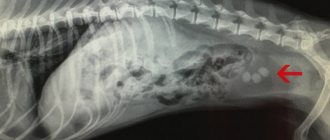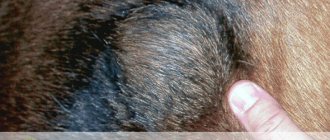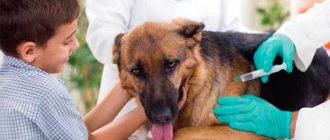Deciphering a general analysis of urine (urine) in dogs helps to identify disturbances in the functioning of internal organs and track inflammatory processes in the urinary tract. This study is often prescribed along with a blood test, since most disorders cause deviations in their indicators.
What situations require testing?
The compliance of indicators with their standard values is checked during annual preventive visits. The rest of the time, the study is carried out when identifying alarming symptoms characteristic of:
- diabetes mellitus;
- diseases of the urinary system;
- poisoning
If the pet is already under treatment, then periodic urine testing is necessary to monitor the effectiveness of the medications taken and the course of the disease. Depending on the results obtained, the doctor adjusts, leaves or cancels the previously prescribed therapy.
Treatment and prevention of proteinuria in dogs
Both treatment and prevention of proteinuria depend on the causes that cause it. For example, a lower urinary tract infection is usually treated with a course of antibiotics. Some dogs with glomerular disease respond positively to treatment, while others do not.
The long-term prognosis for cancer of the urinary tract is generally quite poor.
Even if your dog appears healthy, it may be worth testing for proteinuria in the following situations:
- The dog is middle-aged or older, in which case urine testing should be part of the annual examination.
- The breed of your dog is predisposed to hereditary kidney disease (Soft Coated Wheaten Terrier, Bull Terrier, Dalmatian, Samoyed, Bernese Mountain Dog, Doberman Pinscher, Newfoundland, and English Cocker Spaniel).
- Your dog tests positive for Lyme disease or other vector-borne infections.
Read reviews about our veterinary center. Call the number and schedule a consultation right now or request a call back. (c) Veterinary center for the treatment and rehabilitation of animals “Zoostatus”. Varshavskoe highway, 125 building 1.
source
Physical indicators
Physical indicators include everything that can be measured using the sensory organs. Their norms and deviations are presented in the table.
| Name | Norm | Explanation of possible deviations |
| Color | Straw yellow |
The color intensity directly depends on the density. The higher the specific gravity, the richer and brighter the shade. |
| Smell | Mild |
|
| Transparency | Mild |
|
| Density (specific gravity) | 1.015-1.030 (has no units of measurement, as it is a relative value) | The concentration of urine depends on the functionality of the kidneys. They dilute it with additional fluid obtained from feeding and drinking. Increasing density may mean:
A decrease in density may mean:
|
| Acidity (pH) | 5-7.5 mol/l (slightly acidic) | Acidity depends on the time of day and type of feeding. Alkalinization occurs immediately after eating and when eating plant foods, and oxidation occurs on an empty stomach and with an abundance of protein foods. Increased acidity may mean:
Decreased acidity may mean:
|
The daily volume of excretion of a healthy dog should be 20-40 ml per 1 kg of weight. If you notice changes in the frequency and volume of urination, as well as other suspicious abnormalities, immediately contact the veterinary clinic for examination.
Treatment of elevated protein in urine in dogs
Specific treatment will depend on your dog's diagnosis. In severe cases, your dog may require stabilizing treatment for dehydration, which will consist of intravenous fluids. Glomerular disease will be treated with a combination of immunosuppressants, angiotensin-converting enzyme inhibition, low-dose aspirin, and a special diet low in protein, phosphorus, calcium, and sodium and high in potassium and polyunsaturated fatty acids such as omega-3 and omega-6. In case of kidney inflammation and urinary tract infections, antibiotics are prescribed. High blood pressure will be treated with calcium channel blockers or beta blockers and possibly the recommendation of a low-sodium diet.
Chemical indicators
Most indicators cannot be visually analyzed. To study them, special laboratory equipment is used - analyzers.
The standards and explanation of deviations of the main chemical indicators can be found in the table.
| Name | Norm | Explanation of possible deviations |
| Protein | No more than 0.3 g/l | Excess protein in the body is called proteinuria. Reasons for high protein levels in a dog's urine include:
|
| Urea | 3.5-9.2 g/l | Urea is a breakdown product of proteins. Its value deviates with excess or low consumption of protein foods. Pathological causes include kidney disease. |
| Glucose | Absent | The appearance of undigested glucose is typical for:
. |
| Ketone bodies | None | Directly related to glucose levels. If it is detected, the dog is diagnosed with diabetic acidosis, and if it is not present, it is diagnosed with acidosis associated with toxicosis, gastrointestinal disorder or starvation. Also, the cause of the appearance of ketone bodies may be a serious mechanical injury or an acute form of pancreatitis. |
| Bilirubin and urobilinogen | Absent (the presence of marks is permissible only in males) | Bilirubin in a dog’s urine is a bile pigment, indicating a violation of the outflow of bile, increased breakdown of red blood cells (pyroplasmosis) and liver pathologies. Urobilinogen is a product of its breakdown, so it always appears together with bilirubin. |
| Nitrites | None | Their appearance indicates an infection in the urinary tract |
In healthy urine, protein is an anomaly, so when it is detected, creatinine, the most important participant in energy metabolism in muscles, is examined. The ratio of these indicators should not exceed 0.2.
Causes of proteinuria in dogs
Potential sources of excess protein in urine include all of the various structures within the urinary tract. The protein can also be released from the genital tract, which is anatomically connected to the urinary tract (genital glands, uterus, vagina).
For diagnosis, urine samples must be collected directly from the bladder using a needle through the abdominal wall (cystocentesis), which can help reduce urine contamination by “passenger” protein.
The most common causes of proteinuria include:
- Infections.
- An inflammatory process, for example caused by stones, polyps or tumors.
- Bleeding.
- Damage to the renal glomeruli.
- Large amounts of protein in the bloodstream (hemoglobin, globulin, myoglobin), resulting in it being filtered into the urine.
Microscopy of sedimentary particles
In addition to the liquid component, solid particles that make up the sediment also play an important role. It includes an unorganized part, represented by crystalline salts, and an organized part, containing all other elements.
The explanation of possible values can be found in the table example.
| Name | Norm | Explanation of possible deviations |
| Red blood cells and hemoglobin | No more than 5 cells | Erythrocytes, or red blood cells, are an important element of blood, and hemoglobin is their structural unit. These elements appear in the urine as a result of internal bleeding, turning it scarlet. Possible causes of bleeding include:
|
| Leukocytes | No more than 3 cells | An increased content of leukocytes is characteristic of urolithiasis, urethritis, cystitis and pyelonephritis. |
| Epithelial cells | None | Possible diagnosis depends on the type of epithelium:
The latter type has no diagnostic value. It enters urine from the mucous membranes of the genital organs due to insufficient hygiene. |
| Urinary cylinders | No more than 2 units | Urinary casts are protein compounds formed in the renal tubules. They serve as a cast of the tubules, as they take their shape over time. Periodically, some of the cylinders come out during urination. If there are too many, the diagnosis depends on their variety:
|
| Bacteria and fungi | None | The reason for the violation of the sterility of urine is a violation of the collection and storage of biomaterial, infection and inflammation of the ascending tract of the genitourinary system. |
| Slime | None | A small amount of mucus is not dangerous, since it is secreted by the mucous membranes of the urinary tract. If the consistency of urine has become mucous and viscous, then this is a sign of cystitis. |
| Crystals | Small inclusion allowed | The accumulation of crystals is fraught with the formation of urates - urinary stones that block the exit of urine. The patient is diagnosed based on their type. |
| Sperm | None | Occurs in tests of male dogs when biomaterial is collected incorrectly. |
| Fats (lipids) | None | The appearance of fat is characteristic of atrophic changes in the kidneys or overfeeding with fatty foods. |
| Ascorbic acid (vitamin C) | 5-50 mg/dl | The dog's body is able to independently produce vitamin C, but does not know how to store it. It removes all excess by urinating. An increase in ascorbic acid is associated with hypervitaminosis, which occurs when there is an excess of vitamin C in the diet or medications taken. The decrease occurs due to a lack of vitamin C in foods or a metabolic failure. |
Urine biochemistry is important for monitoring changes in animals suffering from KSD. Therapeutic nutrition, which affects the pH level, leads to changes in stones. Based on the results, the doctor can alternate types of food until the formations are completely eliminated.
Symptoms of proteinuria in dogs
Proteinuria itself does not cause any symptoms. The symptoms that arise are usually determined by the disorder. For example, when proteinuria is caused by a bladder infection, symptoms usually include:
- Frequent urination.
- Difficulty urinating or inability to urinate.
- Blood in urine.
- Unusual smell of urine.
Proteinuria caused by damage to the glomeruli often leads to chronic kidney disease, which may result in the following symptoms:
- Loss of appetite.
- Lethargy/weakness.
- Vomit.
- Increased thirst and diuresis.
How to collect urine for research
Incorrect sampling may result in false negative or positive results. For the accuracy of the study, the owner will also have to take care of storing and transporting the resulting sample to the veterinary clinic.
In bitches
Wash your pet's genitals before a walk and prepare a flat container or bottle with the neck cut off at an angle. Do not use detergents to clean the containers, but simply pour boiling water over them.
When you go outside, wait until the dog sits down to urinate and place the prepared instrument under the stream. Pour the resulting specimen into a special container for collecting urine.
Alternative methods include using a baby urine bag, absorbent diaper, or catheter. In addition to catheterization, the clinic recommends bladder puncture.
In males
Males are more suspicious, so do not reveal the presence of the container before urination begins. It is better to collect biomaterial with a partner to keep the dog on a leash until 20-100 ml of liquid gets into the container.
Remember that male dogs urinate in small amounts. Collecting everything in one go is very problematic. For convenience, you can use a condom:
- Make 2 holes in its base and thread an elastic rope through them.
- Place the resulting product on the dog's penis and tie the ties on his back.
- Wait until the required portion is collected and carefully cut off the tip of the condom.
- Pour the contents into a container.
If there is frequent and light urination, it is better to seek help from a veterinarian. Collecting it yourself using a pipette and syringe will take a lot of time, and any dirt on the floor can greatly distort the results.
Storage and transportation
The collected biomaterial must be taken to the veterinary clinic within half an hour. If this is not possible, then the jar can be placed in the refrigerator for 3 hours. Transportation at a later date will distort the results and complicate the diagnosis.
If your pet often asks to go for a walk, and suspicious inclusions appear in its urine, take the sample to a veterinary clinic for examination. Changes in smell and color are alarming symptoms that require the owner’s attention.
When you receive results, try to understand their meaning, but avoid self-medication. Remember that only a doctor can make an accurate diagnosis.
The article is for informational purposes only. Contact your veterinarian!
Why do dogs leak blood in their urine?
Blood in a dog's urine is almost always a warning sign that there is a serious problem. Bloody discharge may appear for the following reasons:
- Hemolytic poisoning
is intoxication from rat poisons, which act as destroyers of red blood cells. If an animal accidentally swallows such a poison, vomiting, convulsions, pain, and blood clots in the urine may occur. Hemolytics include not only rat poison, but also arsenic, some inedible mushrooms, and snake and spider venoms. It is important to contact a specialist as soon as possible so that he can save the pet by administering sorbents, painkillers, cardiac and rehydration medications. And if you can’t get to the doctor right away, then at home you should induce vomiting by pouring 20-60 ml of slightly warm water into the dog’s mouth. You will also need a water enema and the introduction of sorbents (1 activated carbon per 10 kg of weight). The poisoned poor fellow will need to drink plenty of water, but you shouldn’t feed him;
Urinary tract infections
– very often a dog urinates blood with cystitis, urethritis, pyelonephritis. With such problems, the urine turns red with blood, and the following symptoms may also be observed: pain when trying to relieve a small need, swelling of the genitals (with inflammation of the urethra), temperature, useless attempts to pee, apathy and refusal to eat (due to pain and discomfort ). By the way, with the listed ailments, blood also occurs at the end of urination, when a portion of urine has already been released from the animal’s urethra. And in some cases, only small drops of blood are observed in the urine, which can easily not be noticed, so you will have to pay attention to the general condition of the dog. A disease like this cannot be left to chance. At the clinic, the dog will be prescribed antibiotics, antipyretics, antispasmodics, and rinsing of the urethra and bladder;
von Willebrand disease
– a hereditary pathology in which blood appears from the dog’s urethra, from its nose, and mouth. Heavy bleeding is also observed during surgical interventions (castration, tail docking, etc.). Treatment involves blood and plasma transfusions;
Interpretation of urine test results
The results of physical, chemical and microscopic studies are summarized in a table. Deciphering them makes it possible to get a general picture of the state of the animal’s body. Based on them, data from other tests and examinations, an experienced specialist makes a diagnosis and prescribes treatment.
Physical properties of urine
They are examined by organoleptic analysis. Its essence lies in assessing visual characteristics: color, smell, consistency, presence of visible impurities.
The following indicators are noted:
COL (color) - a yellow and light yellow tint of the liquid is considered normal.
CLA (transparency) - in healthy animals, the discharge is completely transparent.
Presence of sediment - may be present in small quantities. It is formed from insoluble salts, crystals, epithelial cells (kidneys, urethra, bladder, external genitalia), organic compounds, and microorganisms. A large amount of sediment is observed in cases of metabolic disorders and diseases.
Additionally, the presence of an uncharacteristic odor and a change in consistency may be noted.
The owner of the animal should pay attention to the nature of urination and the appearance of the discharge. If there is a change in color or smell, clots of mucus or pus, or blood particles appear when urinating, you should take your dog or cat to the veterinarian.










